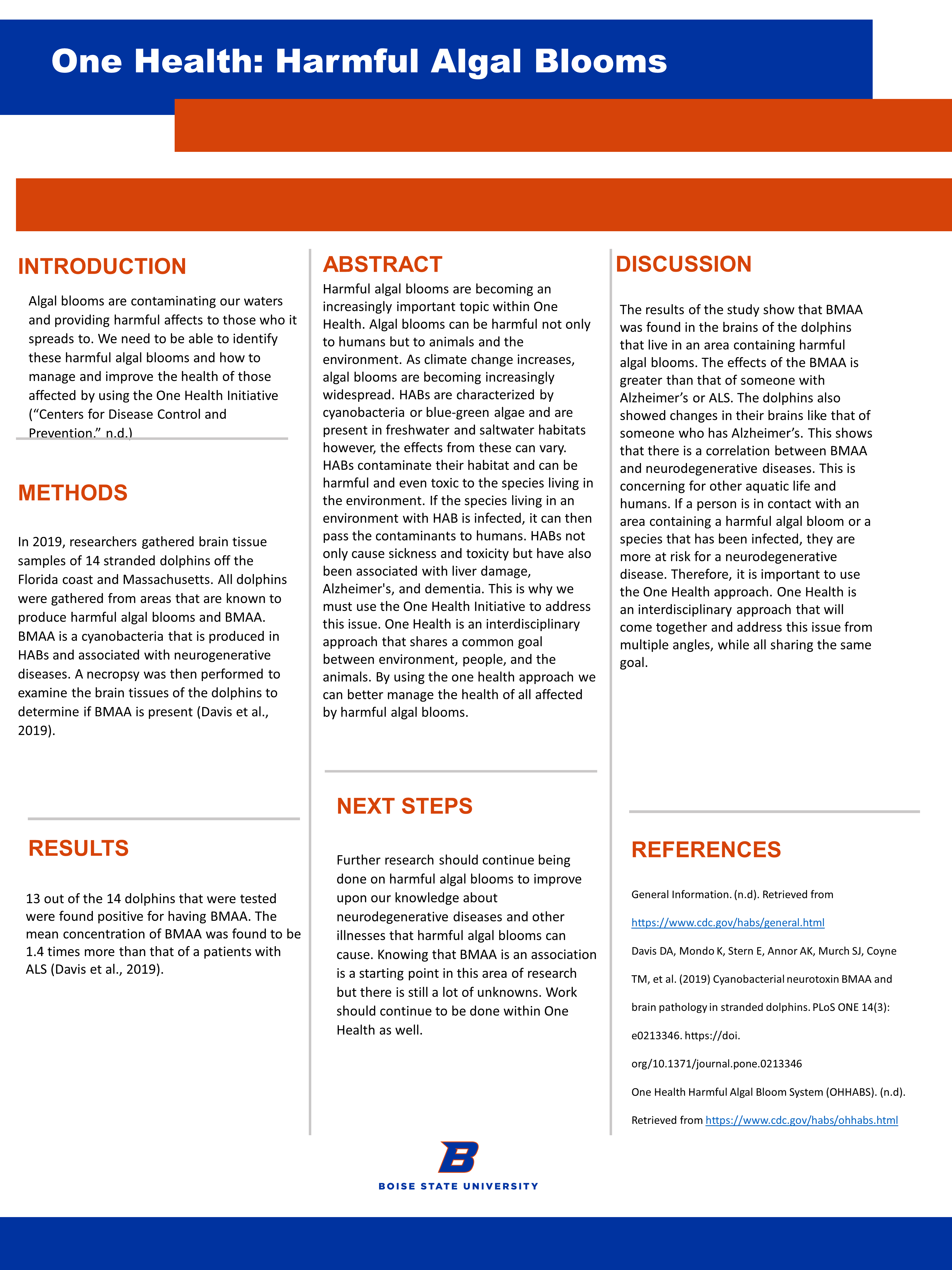Katelyn Hopkins, Dr. Jared Romero

Introduction
Algal blooms are contaminating our waters and providing harmful affects to those who it spreads to. We need to be able to identify these harmful algal blooms and how to manage and improve the health of those affected by using the One Health Initiative (“Centers for Disease Control and Prevention,” n.d.)
Abstract
Harmful algal blooms are becoming an increasingly important topic within One Health. Algal blooms can be harmful not only to humans but to animals and the environment. As climate change increases, algal blooms are becoming increasingly widespread. HABs are characterized by cyanobacteria or blue-green algae and are present in freshwater and saltwater habitats however, the effects from these can vary. HABs contaminate their habitat and can be harmful and even toxic to the species living in the environment. If the species living in an environment with HAB is infected, it can then pass the contaminants to humans. HABs not only cause sickness and toxicity but have also been associated with liver damage, Alzheimer’s, and dementia. This is why we must use the One Health Initiative to address this issue. One Health is an interdisciplinary approach that shares a common goal between environment, people, and the animals. By using the one health approach we can better manage the health of all affected by harmful algal blooms.
Methods
In 2019, researchers gathered brain tissue samples of 14 stranded dolphins off the Florida coast and Massachusetts. All dolphins were gathered from areas that are known to produce harmful algal blooms and BMAA. BMAA is a cyanobacteria that is produced in HABs and associated with neurogenerative diseases. A necropsy was then performed to examine the brain tissues of the dolphins to determine if BMAA is present (Davis et al., 2019).
Results
13 out of the 14 dolphins that were tested were found positive for having BMAA. The mean concentration of BMAA was found to be 1.4 times more than that of a patients with ALS (Davis et al., 2019).
Discussion
The results of the study show that BMAA was found in the brains of the dolphins that live in an area containing harmful algal blooms. The effects of the BMAA is greater than that of someone with Alzheimer’s or ALS. The dolphins also showed changes in their brains like that of someone who has Alzheimer’s. This shows that there is a correlation between BMAA and neurodegenerative diseases. This is concerning for other aquatic life and humans. If a person is in contact with an area containing a harmful algal bloom or a species that has been infected, they are more at risk for a neurodegenerative disease. Therefore, it is important to use the One Health approach. One Health is an interdisciplinary approach that will come together and address this issue from multiple angles, while all sharing the same goal.
Next Steps
Further research should continue being done on harmful algal blooms to improve upon our knowledge about neurodegenerative diseases and other illnesses that harmful algal blooms can cause. Knowing that BMAA is an association is a starting point in this area of research but there is still a lot of unknowns. Work should continue to be done within One Health as well.
References
- General Information. (n.d). Retrieved from
- https://www.cdc.gov/habs/general.html
- Davis DA, Mondo K, Stern E, Annor AK, Murch SJ, Coyne TM, et al. (2019) Cyanobacterial neurotoxin BMAA and brain pathology in stranded dolphins. PLoS ONE 14(3): e0213346. https://doi. org/10.1371/journal.pone.0213346
- One Health Harmful Algal Bloom System (OHHABS). (n.d). Retrieved from https://www.cdc.gov/habs/ohhabs.html